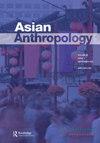Beijing’s Ten Great Buildings: popular responses over three eras (1959-2016)
Q2 Social Sciences
引用次数: 0
Abstract
Abstract Modern Beijing’s original Ten Great Buildings (Shi da jianzhu) in 1959 were iconic markers in the re-building of the city as a modern capital fit for the People’s Republic of China. The idea of modern buildings as gauges of the modernisation of the city took hold in official and popular imaginations. Over the decades since the late Fifties through to the present-day, ordinary Beijingers have debated what parts of their built environment best serve as markers of progress and modernity. This article examines popular responses at three moments in the growth of Beijing. The original set of ten buildings, erected to mark the tenth anniversary of the new state, elicited pride as well as more recent mixed feelings. In 1988, at the most liberal moment in the PRC since 1949, Beijing Daily conducted a readers’ poll for a new set of Ten Great Buildings from the Eighties. A quarter-million people voted for their favourites. In the twenty-first century, as Beijing was further transformed and Beijingers took to the Internet to express their views, alternative lists of ten iconic buildings from the 2000s have been hotly debated.北京十大建筑:三个时代的大众反应(1959-2016)
1959年建成的现代北京十大建筑是重建北京成为符合中华人民共和国现代化首都的标志性建筑。现代建筑作为城市现代化的标尺的想法在官方和大众的想象中占据了一席之地。从50年代末到现在的几十年里,普通北京人一直在争论,他们的建筑环境中哪些部分最适合作为进步和现代化的标志。本文考察了在北京发展过程中的三个时刻,人们的普遍反应。最初的十幢建筑是为了纪念这个新国家成立十周年而建造的,它引起了人们的骄傲,也引起了最近复杂的感情。1988年,在中国自1949年以来最自由的时刻,《北京日报》发起了一项读者投票,选出了新的80年代十大建筑。25万人为他们最喜欢的人投票。进入21世纪,随着北京的进一步转型,北京人开始在互联网上表达自己的观点,21世纪以来的十大标志性建筑也引发了热议。
本文章由计算机程序翻译,如有差异,请以英文原文为准。
求助全文
约1分钟内获得全文
求助全文
来源期刊

Asian anthropology
Social Sciences-Anthropology
CiteScore
1.60
自引率
0.00%
发文量
25
期刊介绍:
Asian Anthropology seeks to bring interesting and exciting new anthropological research on Asia to a global audience. Until recently, anthropologists writing on a range of Asian topics in English but seeking a global audience have had to depend largely on Western-based journals to publish their works. Given the increasing number of indigenous anthropologists and anthropologists based in Asia, as well as the increasing interest in Asia among anthropologists everywhere, it is important to have an anthropology journal that is refereed on a global basis but that is editorially Asian-based. Asian Anthropology is editorially based in Hong Kong, Taiwan, and Japan, but welcomes contributions from anthropologists and anthropology-related scholars throughout the world with an interest in Asia, especially East Asia as well as Southeast and South Asia. While the language of the journal is English, we also seek original works translated into English, which will facilitate greater participation and scholarly exchange. The journal will provide a forum for anthropologists working on Asia, in the broadest sense of the term "Asia". We seek your general support through submissions, subscriptions, and comments.
 求助内容:
求助内容: 应助结果提醒方式:
应助结果提醒方式:


